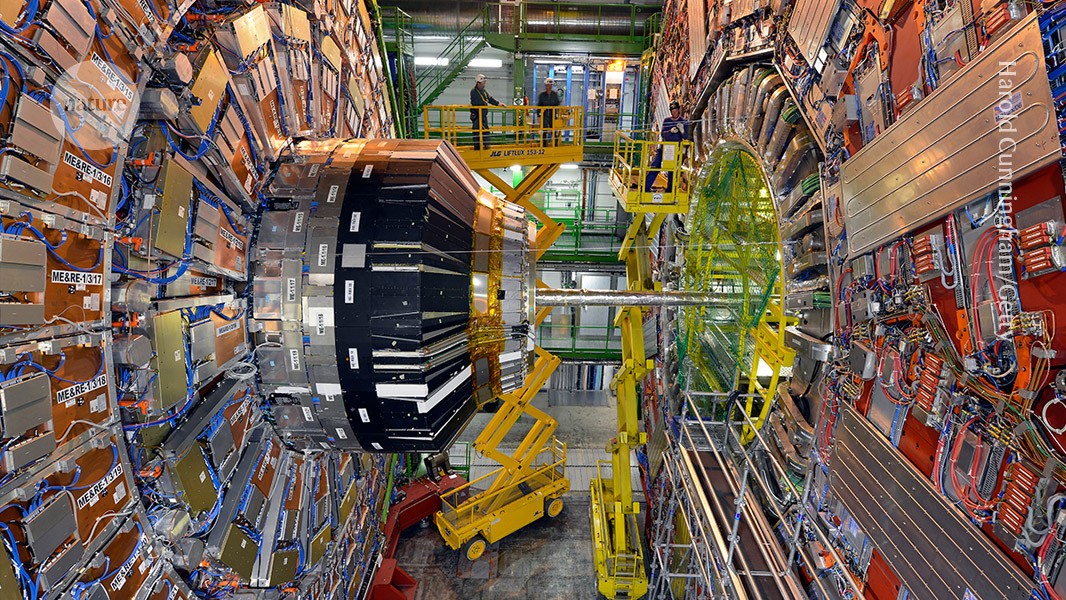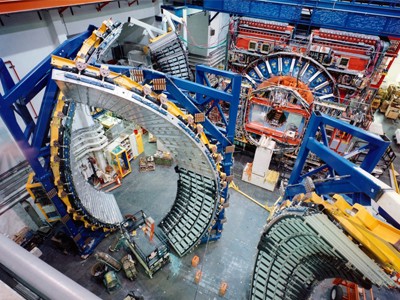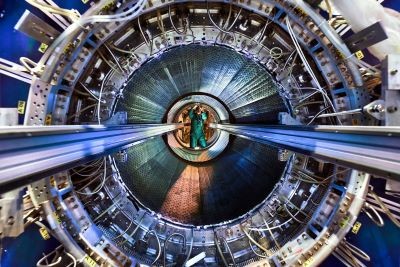Physicists have nailed a fiendishly difficult measurement — the mass of the fundamental particle the W boson. The result, from the CMS experiment at the Large Hadron Collider (LHC), is in line with the predictions of the standard model, and pours cold water on an anomaly in the W boson mass that surfaced in 2022. That measurement had hinted at the existence of phenomena beyond the standard model, physicists’ best description of particles and forces.
Particle’s surprise mass threatens to upend the standard model
“The standard model is not dead,” said Josh Bendavid, a particle physicist at the Massachusetts Institute of Technology in Cambridge and member of the CMS collaboration, when he presented the result on 17 September. Rapturous applause met announcement, made at a seminar at CERN, Europe’s particle-physics laboratory near Geneva, Switzerland, which hosts the LHC. CMS’s result was was 10 years in the making, and produced a mass of 80,360.2 million electronvolts for the W boson, which is involved in carrying the weak nuclear force (see ‘The W boson puzzle’). If it had been close to the 2022 result, “we would be declaring its death”, said Bendavid.
“The community will be excited by the fact that we can reach this precision and have this understanding of the standard model at this level,” says Florencia Canelli, an experimental particle physicist at the University of Zurich in Switzerland, who works on the CMS experiment but was not involved in the result.
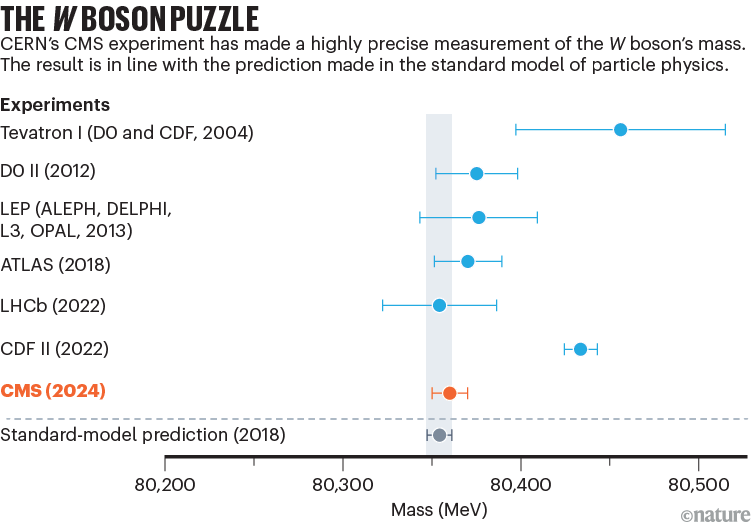
Source: CERN/compiled by Nature
Relief for physicists
The 2022 result1, produced by an experiment called CDF at the Fermi National Accelerator Laboratory in Batavia, Illinois, used 10-year-old data to calculate that the W boson was heavier than predicted, opening the possibility of a crack in the standard model that excited physicists. Although the model is incredibly successful, physicists know it can’t be complete because it doesn’t account for mysterious phenomena such as dark matter.
How the revamped Large Hadron Collider will hunt for new physics
The CMS result is the most precise measurement of the W mass to come out of the LHC, and its precision is roughly on par with the CDF result. It is also in line with the four measurements that preceded the CDF figure, leaving that value as an outlier. “They cannot both be right,” says Ashutosh Kotwal, an experimental particle physicist at Duke University in Durham, North Carolina, who led the CDF study.
“It would have been probably better for the community if we found something totally different from the standard model, because that would have been exciting for the future of our field,” says Elisabetta Manca, a particle physicist at the University of California, Los Angeles, who was one of the main analysts for the CMS finding. But in terms of confidence in the result, the value was a “relief”, she says.
Fundamental forces
W bosons, along with its sister particle, the Z, are involved in radioactive decay as a carrier of the weak nuclear force, one of four fundamental forces of nature. It is one of the few values in the standard model that can be predicted at high precision by theory and also measured through experiments. This makes it a great way to hunt for cracks in the model. “There are not many high-precision observables. That’s what makes it important and worthwhile,” says Kotwal.
Exotic four-quark particle spotted at Large Hadron Collider
But the W mass is extremely difficult to measure. The LHC makes the bosons by colliding protons at extreme energies. These quickly decay into other particles that the experiments detect. But for the W mass, half of the decay is missing, because the boson transforms into only one detectable particle — a lepton, such as an electron or its heavier cousin the muon. The other particle, a neutrino, zips straight out of the detector leaving no trace.
Muon decays
The CMS analysis looked mostly at muon decays. The team reconstructed properties of muons from around 100 million W decays from the LHC with unprecedented precision, says Manca. They then compared the data with 4 billion simulated collisions and decays that used different values for the W mass — and different values for 4,000 other parameters that would change the results — and looked for the best match. “The one that matches is the one we extract,” says Canelli.
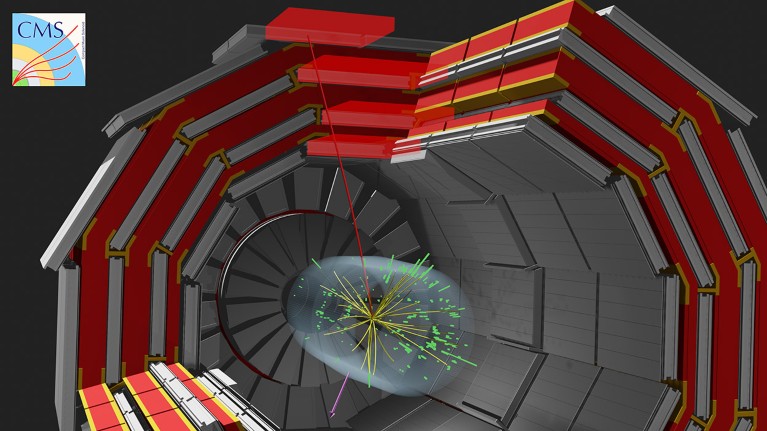
Illustration of a CMS collision event in which a W boson decays into a muon (red line).Credit: CMS/CERN
The team used cutting-edge software and theory, and calibrated and cross-checked their results against other properties of the W and against Z decays to ensure that their methods were working as expected, says Manca.
That the CMS result is broadly in line with those from other LHC experiments — ATLAS and LHCb — which used different detectors and methodologies, gives the team confidence that they have hit on the right figure, says Manca.
Anomaly assessment
No one can yet say why CDF’s result stands out. One possible reason is that the detector used different theoretical tools from CMS to generate its simulations. CDF detected collisions from a proton–antiproton accelerator called the Tevatron, which closed in 2011, whereas the LHC collides only protons. “There is no one thing where we can say ‘that’s the reason why the result is so different,’” says Manca.
Kotwal says he will need to see the CMS paper, which will be published in coming months, to see the team’s methodology. “People have been reviewing how we’ve done it and we haven’t received any clear indication that any flaw has been noticed. The same has to be done for CMS,” he says.
Agreeing on humankind’s best guess of the W’s mass will mean bringing together experts from each of the experiments, as well as theorists, to try to understand the differing results. “We shouldn’t leave the CDF result as an outlier, we need to understand why or how it is there,” says Canelli.
Although CMS did not find an anomaly, the 10-year process created tools that allow physicists to make other precision measurements. Such high-precision comparisons are what Manca thinks will ultimately break open the standard model.


